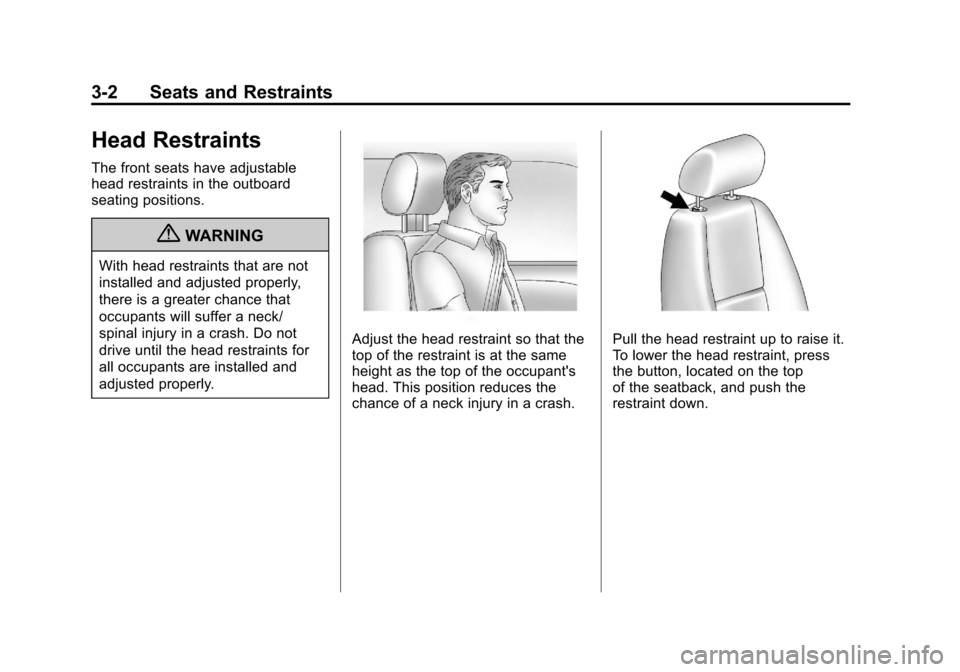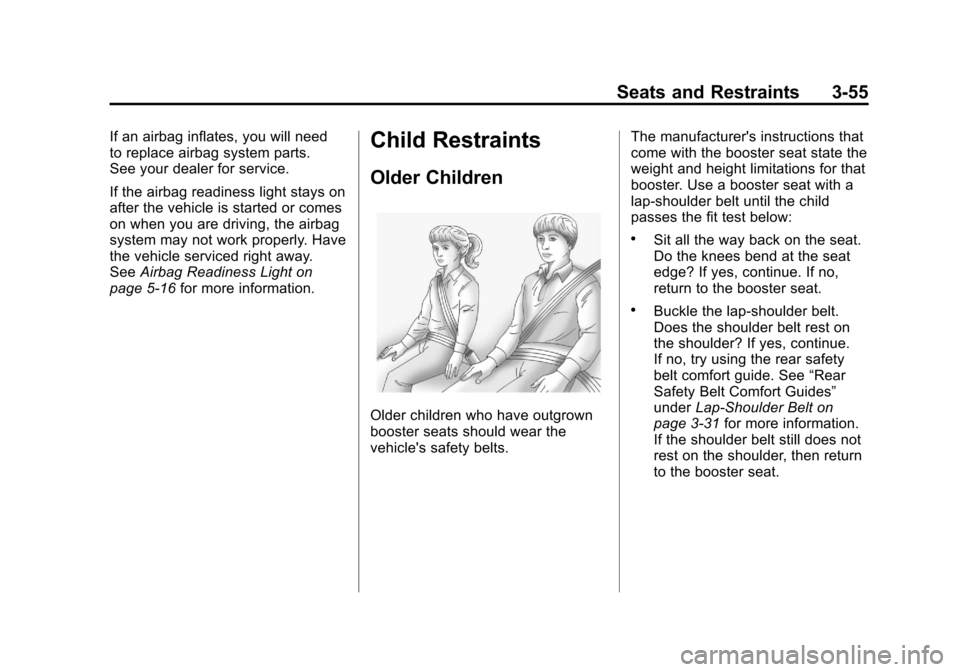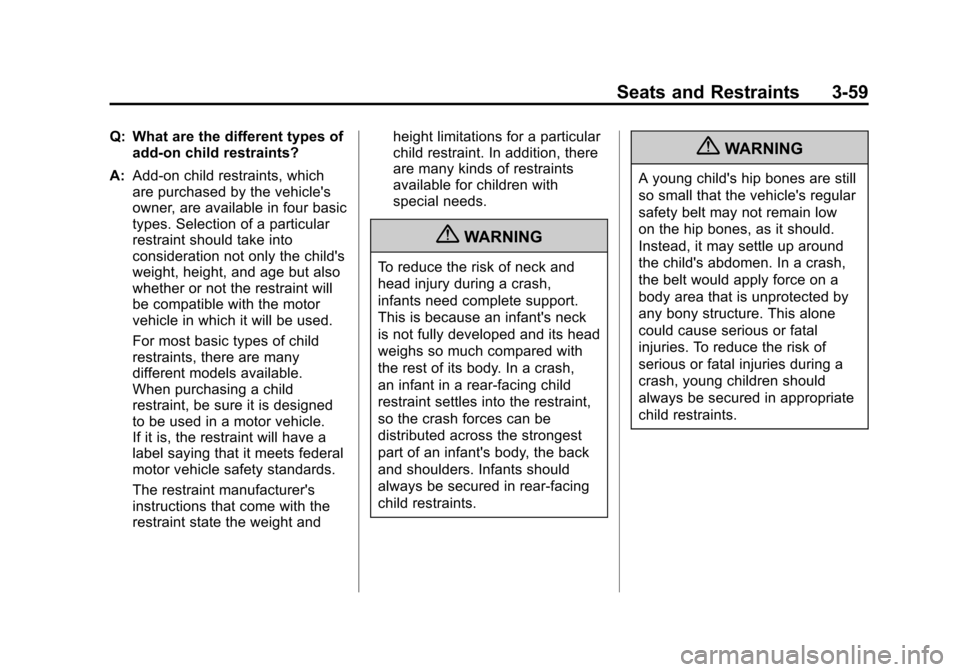2011 CADILLAC ESCALADE height
[x] Cancel search: heightPage 13 of 558

Black plate (7,1)Cadillac Escalade/Escalade ESV Owner Manual - 2011
In Brief 1-7
Seat Adjustment
To adjust the seat:
.Move the seat forward or
rearward by sliding the control
forward or rearward.
.Raise or lower the front or rear
part of the seat cushion by
moving the front or rear of the
control up or down.
.Raise or lower the entire seat
by moving the entire control up
or down.See
Power Seat Adjustment on
page 3‑3 for more information.
Lumbar Adjustment
To adjust the lumbar support:
.To increase or decrease lumbar
support, press and hold the front
or rear of the control.
.To raise or lower the height of
the support, press and hold the
top or bottom of the control.
See Lumbar Adjustment on
page 3‑6 for more information. Reclining Seatbacks
To recline the seatback:
.Tilt the top of the control
rearward to recline.
.Tilt the top of the control forward
to raise.
See Reclining Seatbacks on
page 3‑6 for more information.
Page 16 of 558

Black plate (10,1)Cadillac Escalade/Escalade ESV Owner Manual - 2011
1-10 In Brief
Head Restraint
Adjustment
Do not drive until the head restraints
for all occupants are installed and
adjusted properly.
To achieve a comfortable seating
position, change the seatback
recline angle as little as necessary
while keeping the seat and the
head restraint height in the proper
position.
For more information seeHead
Restraints on page 3‑2 andPower
Seat Adjustment on page 3‑3.
Safety Belts
Refer to the following sections for
important information on how to use
safety belts properly.
.Safety Belts on page 3‑22.
.How to Wear Safety Belts
Properly on page 3‑25.
.Lap-Shoulder Belt on page 3‑31.
.Lower Anchors and Tethers for
Children (LATCH System) on
page 3‑63.
Sensing System for
Passenger Airbag
The passenger sensing system,
if equipped, will turn off the right
front passenger frontal airbag
under certain conditions. The driver
airbags, seat‐mounted side impact
airbags and roof‐rail airbags are not
affected by this.
If the vehicle has one of the
indicators pictured in the following
illustrations, then the vehicle has a
passenger sensing system for the
right front passenger position.
The passenger airbag status
indicator, if equipped, will be visible
on the overhead console when the
vehicle is started.
Page 58 of 558

Black plate (2,1)Cadillac Escalade/Escalade ESV Owner Manual - 2011
3-2 Seats and Restraints
Head Restraints
The front seats have adjustable
head restraints in the outboard
seating positions.
{WARNING
With head restraints that are not
installed and adjusted properly,
there is a greater chance that
occupants will suffer a neck/
spinal injury in a crash. Do not
drive until the head restraints for
all occupants are installed and
adjusted properly.
Adjust the head restraint so that the
top of the restraint is at the same
height as the top of the occupant's
head. This position reduces the
chance of a neck injury in a crash.Pull the head restraint up to raise it.
To lower the head restraint, press
the button, located on the top
of the seatback, and push the
restraint down.
Page 62 of 558

Black plate (6,1)Cadillac Escalade/Escalade ESV Owner Manual - 2011
3-6 Seats and Restraints
A single beep sounds. The driver
seat moves back approximately
8 cm (3 in) and the power steering
column moves up and forward.
To move the seat back farther,
press the easy exit button again
until the seat is all the way back.
If something has blocked the driver
seat while recalling the exit position,
the recall may stop. Remove the
obstruction; then press and hold
the power seat control rearward for
two seconds. Try recalling the exit
position again. If the exit position is
still not recalling, see your dealer for
service.
See“Easy Exit Recall” and
“Easy Exit Setup” underVehicle
Personalization on page 5‑40 for
more information.Lumbar Adjustment
Power Lumbar
To adjust the lumbar support:
.To increase or decrease lumbar
support, press and hold the front
or rear of the control.
.To raise or lower the height of
the lumbar support, press and
hold the top or bottom of the
control.
Reclining Seatbacks
Power Reclining Seatbacks
{WARNING
You can lose control of the
vehicle if you try to adjust the
seat while the vehicle is moving.
The sudden movement could
startle and confuse you, or make
you push a pedal when you do
not want to. Adjust the driver seat
only when the vehicle is not
moving.
Page 89 of 558

Black plate (33,1)Cadillac Escalade/Escalade ESV Owner Manual - 2011
Seats and Restraints 3-33
4. If equipped with a shoulderbelt height adjuster, move it to
the height that is right for you.
See “Shoulder Belt Height
Adjuster” in this section for
instructions on use and
important safety information.
5. To make the lap part tight, pull
up on the shoulder belt.
It may be necessary to pull
stitching on the safety belt
through the latch plate to fully
tighten the lap belt on smaller
occupants. To unlatch the belt, push the button
on the buckle. The belt should
return to its stowed position.
Before a door is closed, be sure
the safety belt is out of the way. If a
door is slammed against a safety
belt, damage can occur to both the
belt and the vehicle.
Shoulder Belt Height Adjuster
The vehicle has a shoulder belt
height adjuster for the driver and
right front passenger positions.
Adjust the height so the shoulder
portion of the belt is on the
shoulder and not falling off of it.
The belt should be close to, but
not contacting, the neck. Improper
shoulder belt height adjustment
could reduce the effectiveness of
the safety belt in a crash. See
How
to Wear Safety Belts Properly on
page 3‑25.
Squeeze the buttons (A) on the
sides of the height adjuster and
move the height adjuster to the
desired position.
The adjuster can be moved up just
by pushing up on the shoulder belt
guide.
After the adjuster is set to the
desired position, try to move it
down without squeezing the buttons
to make sure it has locked into
position.
Page 109 of 558

Black plate (53,1)Cadillac Escalade/Escalade ESV Owner Manual - 2011
Seats and Restraints 3-53
WARNING (Continued)
proper service procedures, and
make sure the person performing
work for you is qualified to do so.
Adding Equipment to the
Airbag-Equipped Vehicle
Q: Is there anything I might addto or change about the vehicle
that could keep the airbags
from working properly?
A: Yes. If you add things that
change the vehicle's frame,
bumper system, height, front
end or side sheet metal, they
may keep the airbag system
from working properly. Changing
or moving any parts of the front
seats, safety belts, the airbag
sensing and diagnostic module,
steering wheel, instrument panel, roof-rail airbag modules,
ceiling headliner or pillar garnish
trim, overhead console, front
sensors, side impact sensors,
or airbag wiring can affect the
operation of the airbag system.
In addition, the vehicle may have
a passenger sensing system
for the right front passenger
position, which includes sensors
that are part of the passenger
seat. The passenger sensing
system may not operate properly
if the original seat trim is
replaced with non-GM covers,
upholstery or trim, or with
GM covers, upholstery or
trim designed for a different
vehicle. Any object, such as
an aftermarket seat heater or
a comfort enhancing pad or
device, installed under or on top
of the seat fabric, could also
interfere with the operation of
the passenger sensing system.This could either prevent proper
deployment of the passenger
airbag(s) or prevent the
passenger sensing system
from properly turning off the
passenger airbag(s).
See
Passenger Sensing
System on page 3‑48.
If you have any questions,
call Customer Assistance.
The phone numbers and
addresses for Customer
Assistance are in Step Two
of the Customer Satisfaction
Procedure in this manual.
See Customer Satisfaction
Procedure (U.S. and Canada) on
page 13‑1 orCustomer
Satisfaction Procedure (Mexico)
on page 13‑3.
If the vehicle has rollover
roof-rail airbags, see Different
Size Tires and Wheels on
page 10‑68 for additional
important information.
Page 111 of 558

Black plate (55,1)Cadillac Escalade/Escalade ESV Owner Manual - 2011
Seats and Restraints 3-55
If an airbag inflates, you will need
to replace airbag system parts.
See your dealer for service.
If the airbag readiness light stays on
after the vehicle is started or comes
on when you are driving, the airbag
system may not work properly. Have
the vehicle serviced right away.
SeeAirbag Readiness Light on
page 5‑16 for more information.Child Restraints
Older Children
Older children who have outgrown
booster seats should wear the
vehicle's safety belts. The manufacturer's instructions that
come with the booster seat state the
weight and height limitations for that
booster. Use a booster seat with a
lap-shoulder belt until the child
passes the fit test below:
.Sit all the way back on the seat.
Do the knees bend at the seat
edge? If yes, continue. If no,
return to the booster seat.
.Buckle the lap-shoulder belt.
Does the shoulder belt rest on
the shoulder? If yes, continue.
If no, try using the rear safety
belt comfort guide. See
“Rear
Safety Belt Comfort Guides”
under Lap-Shoulder Belt on
page 3‑31 for more information.
If the shoulder belt still does not
rest on the shoulder, then return
to the booster seat.
Page 115 of 558

Black plate (59,1)Cadillac Escalade/Escalade ESV Owner Manual - 2011
Seats and Restraints 3-59
Q: What are the different types ofadd-on child restraints?
A: Add-on child restraints, which
are purchased by the vehicle's
owner, are available in four basic
types. Selection of a particular
restraint should take into
consideration not only the child's
weight, height, and age but also
whether or not the restraint will
be compatible with the motor
vehicle in which it will be used.
For most basic types of child
restraints, there are many
different models available.
When purchasing a child
restraint, be sure it is designed
to be used in a motor vehicle.
If it is, the restraint will have a
label saying that it meets federal
motor vehicle safety standards.
The restraint manufacturer's
instructions that come with the
restraint state the weight and height limitations for a particular
child restraint. In addition, there
are many kinds of restraints
available for children with
special needs.
{WARNING
To reduce the risk of neck and
head injury during a crash,
infants need complete support.
This is because an infant's neck
is not fully developed and its head
weighs so much compared with
the rest of its body. In a crash,
an infant in a rear-facing child
restraint settles into the restraint,
so the crash forces can be
distributed across the strongest
part of an infant's body, the back
and shoulders. Infants should
always be secured in rear-facing
child restraints.
{WARNING
A young child's hip bones are still
so small that the vehicle's regular
safety belt may not remain low
on the hip bones, as it should.
Instead, it may settle up around
the child's abdomen. In a crash,
the belt would apply force on a
body area that is unprotected by
any bony structure. This alone
could cause serious or fatal
injuries. To reduce the risk of
serious or fatal injuries during a
crash, young children should
always be secured in appropriate
child restraints.